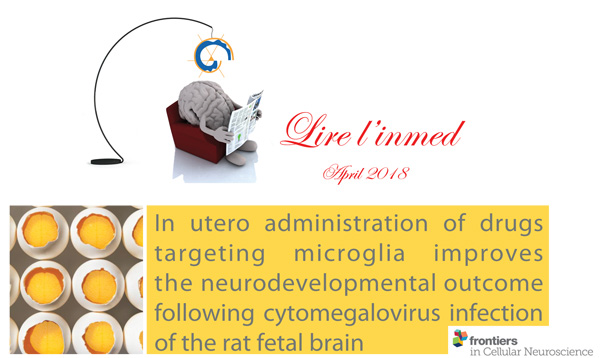The yin and yolk. The recent resurgence of zika virus reminds us how vulnerable the developing brain is and why it is crucial to protect it from viral infections. Cytomegalovirus (CMV) strikes at neuron’s most precious ally: microglia. Whereas, true to their origin in the yolk sac, they nurture and protect the brain, microglia lead to dreadful neurological afflictions once they are immuno activated in the context of CMV infection. The authors show that treating pups in utero with a second-generation tetracycline blocks the immune activation of microglia and improves the survival of newborns and their neurological fate. (Ingrid Bureau)
Authors of the publication: Cloarec, Bauer, Teissier, Schaller, Luche, Courtens, Salmi, Pauly, Bois, Pallesi-Pocachard, Buhler, Michel, Gressens, Malissen, Stamminger, Streblow, Bruneau & Szepetowski.
SCIENTIFIC ABSTRACT: Congenital cytomegalovirus (CMV) infections represent one leading cause of neurodevelopmental disorders. Recently, we reported on a rat model of CMV infection of the developing brain in utero, characterized by early and prominent infection and alteration of microglia—the brain-resident mononuclear phagocytes. Besides their canonical function against pathogens, microglia are also pivotal to brain development. Here we show that CMV infection of the rat fetal brain recapitulated key postnatal phenotypes of human congenital CMV including increased mortality, sensorimotor impairment reminiscent of cerebral palsy, hearing defects, and epileptic seizures. The possible influence of early microglia alteration on those phenotypes was then questioned by pharmacological targeting of microglia during pregnancy. One single administration of clodronate liposomes in the embryonic brains at the time of CMV injection to deplete microglia, and maternal feeding with doxycyxline throughout pregnancy to modify microglia in the litters’ brains, were both associated with dramatic improvements of survival, body weight gain, sensorimotor development and with decreased risk of epileptic seizures. Improvement of microglia activation status did not persist postnatally after doxycycline discontinuation; also, active brain infection remained unchanged by doxycycline. Altogether our data indicate that early microglia alteration, rather than brain CMV load per se, is instrumental in influencing survival and the neurological outcomes of CMV-infected rats, and suggest that microglia might participate in the neurological outcome of congenital CMV in humans. Furthermore this study represents a first proof-of-principle for the design of microglia-targeted preventive strategies in the context of congenital CMV infection of the brain.
See more work of the team here

